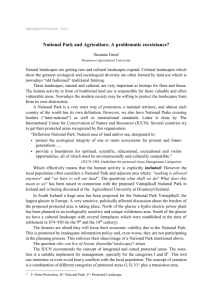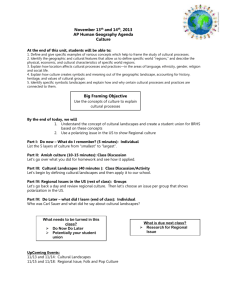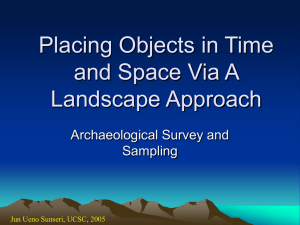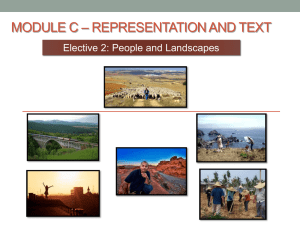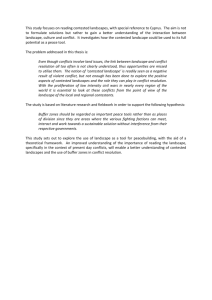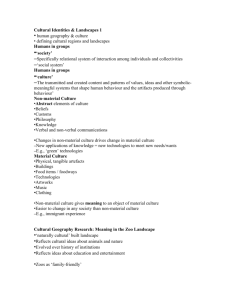Chapter 7: Social Identities and Landscapes
advertisement
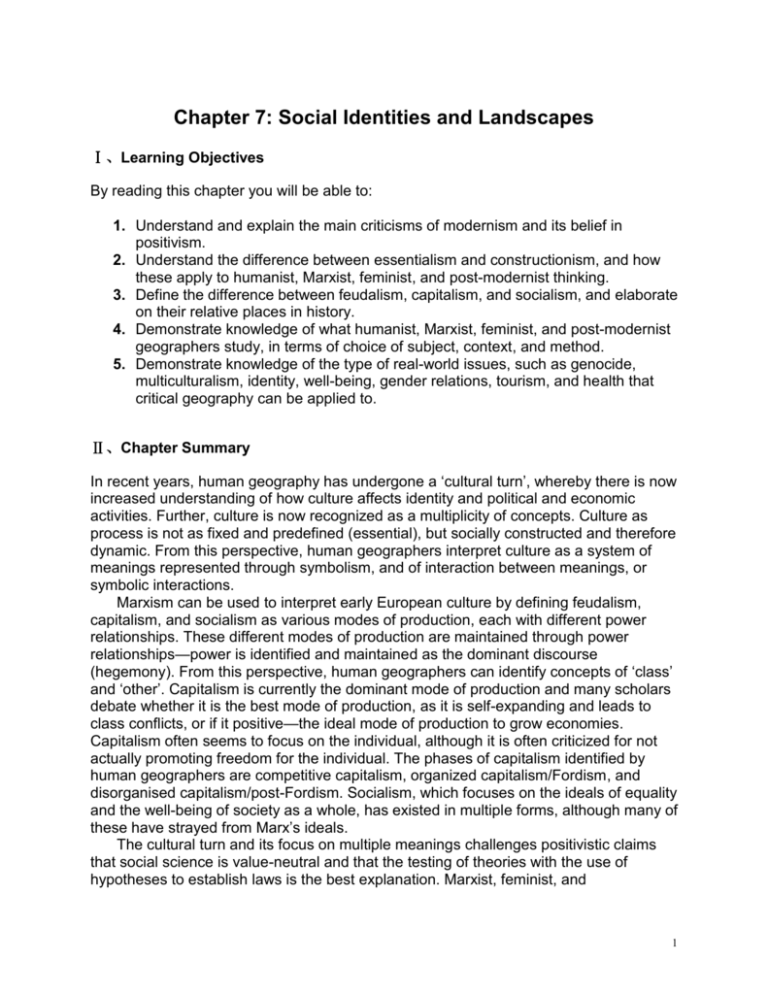
Chapter 7: Social Identities and Landscapes Ⅰ、Learning Objectives By reading this chapter you will be able to: 1. Understand and explain the main criticisms of modernism and its belief in positivism. 2. Understand the difference between essentialism and constructionism, and how these apply to humanist, Marxist, feminist, and post-modernist thinking. 3. Define the difference between feudalism, capitalism, and socialism, and elaborate on their relative places in history. 4. Demonstrate knowledge of what humanist, Marxist, feminist, and post-modernist geographers study, in terms of choice of subject, context, and method. 5. Demonstrate knowledge of the type of real-world issues, such as genocide, multiculturalism, identity, well-being, gender relations, tourism, and health that critical geography can be applied to. Ⅱ、Chapter Summary In recent years, human geography has undergone a ‘cultural turn’, whereby there is now increased understanding of how culture affects identity and political and economic activities. Further, culture is now recognized as a multiplicity of concepts. Culture as process is not as fixed and predefined (essential), but socially constructed and therefore dynamic. From this perspective, human geographers interpret culture as a system of meanings represented through symbolism, and of interaction between meanings, or symbolic interactions. Marxism can be used to interpret early European culture by defining feudalism, capitalism, and socialism as various modes of production, each with different power relationships. These different modes of production are maintained through power relationships—power is identified and maintained as the dominant discourse (hegemony). From this perspective, human geographers can identify concepts of ‘class’ and ‘other’. Capitalism is currently the dominant mode of production and many scholars debate whether it is the best mode of production, as it is self-expanding and leads to class conflicts, or if it positive—the ideal mode of production to grow economies. Capitalism often seems to focus on the individual, although it is often criticized for not actually promoting freedom for the individual. The phases of capitalism identified by human geographers are competitive capitalism, organized capitalism/Fordism, and disorganised capitalism/post-Fordism. Socialism, which focuses on the ideals of equality and the well-being of society as a whole, has existed in multiple forms, although many of these have strayed from Marx’s ideals. The cultural turn and its focus on multiple meanings challenges positivistic claims that social science is value-neutral and that the testing of theories with the use of hypotheses to establish laws is the best explanation. Marxist, feminist, and 1 post-modernist approaches all accept that social science as research is interpretive, and that the researcher is defined by positionality, that is, their ideological preferences and identity impacts their interpretation of results. Humanists focus on a sense of place. Marxists focus on social inequalities as they are expressed through cultural symbolism, gender, and sexuality. Feminists suggest that the fundamental inequality which exists between women and men is due to the patriarchal structure of society and that gender is socially constructed, rather than an essential quality. While modernism developed out of positivism, post-modernism is the idea that reality cannot be studied objectively and, therefore, multiple interpretations are possible. Post-modernist research emphasises deconstruction and focuses on differences and uniqueness. These critical perspectives are highly relevant to discussions of difference, power, and inequality. These discussions might include a look at ethnicity, race, genocide, multiculturalism, gender and sexuality, well-being, and health. Many of these are based on fluid definitions often with disagreement, or lack of alignment between the definition by a specific group of ‘otherness’ and the definition put on that group by the dominant discourse. Consider that race is ill-defined when applied to differentiating between groups of humans. Also consider that when gender is thought to be socially constructed, there emerges a fluidity of gender which goes beyond male and female, addressing both biology and behaviour. Tourism is another area of study for human geographers where the concepts of ‘otherness’ come into play: tourism hinges on the creation of identity for a touristic region, often in relation to the expectations and self-identify of tourists. In this way, tourism spots are mutually constructed by local people and by tourists. Hence critical geographies and concepts of positionality and recognizing differences, gender, and power are all relevant to examinations of many social and political issues and how these relate to place. Ⅲ the key points of the text Rethinking Culture Traditionally culture has been studied in terms of its impact on landscape and through the formation of regions. Sauer’s view of ‘culture as a cause’ was not questioned until the 1980s, when a new debate emerged. There are new means to view culture and societies (and their structures, changes, and spatial variations), which have grown out of deep discourse about the nature of society and how our cultures interact with our environments (not just physical) to give rise to new landscapes— landscapes altering our society, and society altering the landscape. A Symbolic View This concept focuses on the spatial nature of culture and the importance of interactions and communications. Mead proposed that humans learn the meanings of things through social interactions and that human behaviour is a response to the perceived environment. 2 New Cultural Geography There is a plurality of cultures that groups share in specific places at specific times. Culture is a process. As a new understanding of landscape (that landscape is socially constructed) has evolved, two separate views have emerged. The essentialist concept views the characteristics that describe identity as inherited and unchanging, while the constructionist view argues that the features that describe human identity are social and vary in importance to different places at different times. Types of Society According to Marxist logic, each type of society is an example of a mode of production. Feudalism In a feudalist society, all land was owned by the king and managed by his vassals in exchange for their political and military support. Peasants were allowed to live on the land in exchange for their labour and were subject to the legal and political control of their individual lords. People were identified by their social class; social mobility was extremely limited. Capitalism In a capitalist society labour is a commodity that can be bought and sold. The capitalist class owns the means of production, and this ownership creates class differences that often lead to conflict. While Marx viewed capitalism as an exploitation of the working class, Weber viewed it as an ideal type of state. The contemporary world is dominated by capitalism, and the concept of class has become more important as an expression of self-identity. Socialism A socialist society is built on the idea of the common ownership of the means of production. The focus of this society is on community, equality, the well-being of a society, and the idea of a classless society. 3 Social Theory Diversity of Current Approaches The mid-twentieth century was dominated by positivistic attitudes that focused on the development of social theories. The late 1960s led to the emergence of alternative approaches that encouraged interpretative efforts. Humanism and Marxism Revisited Humanists are interested in space, symbolic landscape, and iconography. Marxists are interested in social inequalities reflected in space. Both schools of thought recognize the importance of space in social life. Feminist Theory Various schools of feminist thought exist, but they all have one common goal: improving the social status of women and achieving equality between men and women. Culture is held responsible for the construction of gender differences through different socialization processes. Patriarchy is considered the principle reason for inequality. Structuration Giddens focuses on the role of the individual working as an agent within both a local social system and larger social structures. Structuration is a set of rules made by humans to facilitate human survival. Dualism noted the following: The social structure allows human behaviour to influence and reframe culture. The rules of social structure constrain human behaviour by limiting possible actions, but human behaviour is not determined. One can relate this back to our view of environmental determinism in that possibilities exist and not certainties. Modernism Modernism refers to the tradition-breaking movements that began in the mid-nineteenth century. Modernism believes that reality can be both studied objectively and represented effectively. It is closely linked to industrialization and capitalism. 4 Postmodernism There are many versions of postmodern theory. The postmodernist alternative Reality cannot be accurately represented and truth is relative. This alternative emphasizes the deconstruction of texts and construction of narratives that focus on differences, uniqueness, irrationality, and marginal population. Diverse postmodernisms The concept of postmodernism varies across disciplines but the central focus is always diversity and the need to deconstruct the ideas and texts of those things we have held as more true than others. From that point, it is possible to then see the deeper meanings and power relations among various groups that determine how we create and hold our culture and social structures. The cultural turn There has been an increased appreciation of the role of culture in understanding humans and their political and economic activities. The idea of contextualism—the need to know how knowledge is being utilized—is associated with cultural turn. Like all viewpoints, the modernist and postmodernists approaches have seen reactions from others who hold views more strictly aligned with positivism or even Marxism. Landscape as Place Landscapes are not simply locations. They are also ‘places’ that convey a meaning. A place has a human meaning that is based on social matters. Places as Social Creations Johnston studied regions as human creations that are self-reproducing entities. They are not separate from individual members of society and they are often potential sources of conflict. Studying Places The meaning given to a place is not individualistic but intersubjective; it is based on a shared experience. The emotional attachment between a place and a person represents specific feelings. The degree to which 5 something in the environment displays the characteristics of a place or placelessness determines its consideration on a local or a global scale. Vernacular Regions Creating a Vernacular Region A vernacular region is a region with specific values and meanings and a social and symbolic identity. Delimiting Vernacular Regions One way to delimit a vernacular region is to conduct a survey and collect responses from average people. Zelinsky studied vernacular regions but avoided conducting surveys. Instead, he studied the frequency of a specific regional term and a general national term in metropolitan business usage. Vernacular Regions and Sense of Place Vernacular regions convey specific meanings and emotional attachments that have more value for those living in the region than those located outside the region. Some regions have powerful identities and even the mention of their name creates mental images. Psychogeography The objective of psychogeography is to identify an internal self-image of a region without any external references. An interesting example is the idea of topophila and topophobia—the love of a place and the dislike of a place. Our sense of place, home, and other places outside our own region can have significant bearing on our interactions. Homelands For a region to be categorized as a homeland there must be a sufficient population that will identify it as such. The categorization considers people, place, sense of place, and control of place. There is also the use of the term homeland in our social dictionary today that also points to the idea of control (protection) of our place—and this is not a new term of idea as a review of past uses of the terms homeland, motherland, and fatherland point to. 6 Ethnicity Raitz defined an ethnic group as a group that has a common cultural tradition and constitutes a minority in the society where it is located. Race is commonly used to identify different people on the basis of skin colour; however, it is a fact that race does not exist. Some groups are regarded as minorities on the basis of religion, language, and ethnicity that make them different from the majority. Human geographers use the term ‘ethnic’ to identify and discuss cultural regions. Ethnic Areas Ethinic areas, such as a ghetto, are created as the initial step in the residential segregation of immigrants. Assimilation or acculturation with the larger culture eventually occurs. The assimilation is determined by the degree of spatial proximity between the ethnic area and its homeland and the impact of state policies. Landscape and Power Relations Discovering Difference and Inequality In the 1970s a political dimension was added to human geography in terms of the considerations of differences and inequality. Over the years the dimension has grown to include quality of life, elitist landscapes, and landscapes of stigma and gender. Gender in the Landscape Visible and symbolic landscapes often reflect the inequalities of power that exist between women and men. Cultural and biological reasons have been used to explain the differences in the work and life of men and women. The city morphology reinforces traditional gender roles. Gender and Human Development Australia and Belgium are at the top of the gender-sensitive index of human development, a list that shows rankings as they pertain to reflecting gender inequality. Landscapes of Resistance Dominant groups reflect their own characteristics by constructing landscapes. Places have, therefore, often become points of conflict between different groups of people. 7 Some groups understand themselves only in relation to others (for example, the Afrikaners imposed their views on the indigenous Black population). Ethnicity, gender, and sexuality are not the only grounds for exclusion from the majority group. The homeless, the unemployed, and the disabled are all easily isolated. Well-being Landscapes vary depending on the well-being of their occupants as measured on various spatial scales: local, regional, and global. Welfare geography refers to issues of social justice and equality. Crime The main focus of human geographers in this field has been to relate crime to spatial and social contexts. Two areas of concern are the relationship between areas of criminal activity and urban decline how the use of space is affected by concerns about the likelihood of criminal acts Health and Health Care Health issues are related to various economic factors, social factors, and the availability of services. Issues to consider relate to aging populations and income (those of a current retired generation have more income at hand, generally) and the availability of health care and costs to any health care system where the largest group using the system are older people who are making up a greater and greater proportion of the population. Elitist Landscapes All cities have different areas that are associated with different social classes. In the privileged areas identity and landscape are closely related. Landscapes of Stigma Landscapes of stigma reflect landscapes of exclusion and social injustice. This type is characterized by landscapes of despair (homelessness) and landscapes of fear (safe/unsafe areas). Folk Culture and Popular Culture Folk culture is found primarily in rural areas and usually among distinctive ethnic groups. It often represents resistance to change. Popular culture is mainly urban and is open to change. 8 Folk Culture Folk culture has a strong sense of place and is more traditional, less subject to change, and more homogeneous than popular culture. The factor that unifies folk culture is usually religion, though kinship is also very important. Popular Culture Popular culture trends spread rapidly. The greatest impact of popular culture on landscape can be seen in terms of developments like shopping malls. Sports are extremely also important in popular culture, and landscape regions can be defined in terms of sporting preferences. Group Engineering in a Globalizing World? Cultural variables such as language, religion, ethnicity, class, gender, and sexuality are all human creations. Should humans undertake a process to bridge all the gaps and inequalities? Is it even worthwhile to consider a single social structure or global culture within a world that is increasingly connected? Ⅳ、Study Questions 1、Short Answer Questions 1. Briefly describe what is meant by ‘positionality’ of the researcher. Answer: The idea of positionality contests the positivistic claim that research can be value neutral. Post-modern perspectives claim that the researcher cannot be neutral and so, instead, it is important for the researcher to identify their own ideological preferences and identity and examine how this relates to the research subject. 2. How can gender be perceived in landscape? Answer: Gender can be studied in landscape through the identification of the reproduction of gender roles and relationships. Symbols of patriarchy—male dominance over females—can be seen in cultural symbolism, such as the choice of statues or names of places. Further, gender can be perceived in the design of space in terms of how genders interact in these places and the associated power relations. 3. How do human geographers incorporate queer theory into their studies? Answer: Queer theory is seen in human geography through the identification and study of the fluidity of sexuality in space. In particular, geographers might study the gradual identification of some parts of urban centres as a commercial area 9 where gays and lesbians frequent. Further to this, it is studied how these informal ‘gay’ versus ‘straight’ boundaries arise, and the opposition to the use of space outside this commercial district for gay and lesbian activities and celebration. 4. What is the difference between mass tourism and ecotourism? Answer: Mass tourism is a form of mass consumption, involving the purchase of commodities and the continual development of new attractions—often different sites are essentially similar, leading to the homogenization of place. Meanwhile, ecotourism wants participants to experience a distinctive ecosystem that is different from other places and to limit their consumption in an attempt to lessen tourist impact on land. 5. How is ethnicity often poorly defined? Answer: One researcher examined 65 studies of ethnicity and found that 52 did not offer an explicit definition of ethnicity. Much confusion results from the fact that ethnicity is a concept which defines a social group not living in its homeland in which the members perceive themselves as sharing a common ancestry and culture and therefore different than others in the host country. This difference may be difficult to define and further confusion occurs when the terms ‘race’ and ‘minority’ are used in definitions, since these terms are highly contested in themselves. 2、Research Questions 1. Drawing from examples, discuss the history of the concept of ‘genocide’. Discuss which international bodies are concerned with it and why it is difficult to define and identify its occurrence. 2. Drawing from examples, describe the factors that facilitated the rise of mass tourism. Discuss the benefits and drawbacks of this form of economic development in locales. 3. Discuss how feminist geographers study gender and landscape and, drawing from examples, describe the importance of this type of study. 4. Examine how human geographers study regions and sense of place. What are the features of the regions they select to study? What are their methods of analysis? 5. How is Marxist theory relevant to the study of social identities and landscapes? Drawing from examples, describe the relevance of Marxist theory to contemporary human geography. 3、Links of Interest United Nations Agreements on Human Rights http://www.hrweb.org/legal/undocs.html Ethnologue Language Index http://www.ethnologue.com/country_index.asp UNESCO’s Multilingualism in Cyberspace http://portal.unesco.org/ci/en/ev.php-URL_ID=16539&URL_DO=DO_TOPIC&URL_SEC TION=201.html Religion and Place http://www.religionandplace.org.uk/ The Pew Forum on Religion and Public Life http://religions.pewforum.org/ 10

